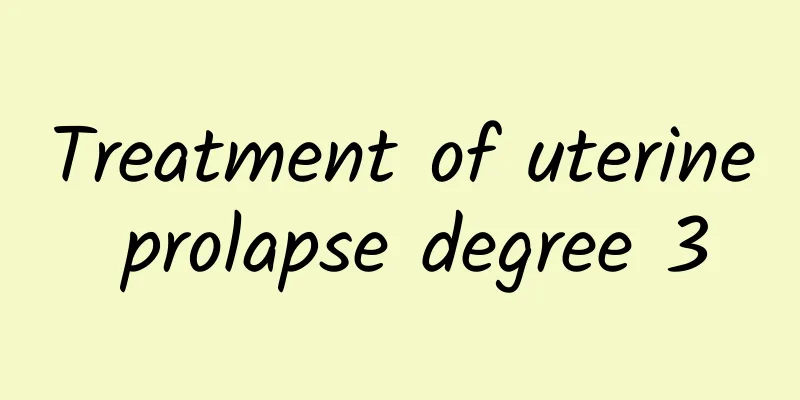Treatment of uterine prolapse degree 3

|
For uterine prolapse of grade 3, appropriate treatment methods should be selected according to the severity of the disease, including conservative treatment, surgical treatment and lifestyle intervention. Among them, surgical treatment is the most common and effective solution for uterine prolapse of grade 3. For patients with uterine prolapse grade 3, conservative treatment is usually suitable for people with mild symptoms who are temporarily unsuitable for surgery. You can choose to wear a pessary device, which is a support device that supports the uterus by placing it in the vagina to relieve prolapse symptoms. Drug treatment can improve the elasticity of vaginal tissue through the use of local estrogen, but its effect is limited and is mainly auxiliary support. If prolapse seriously affects the quality of life, surgical intervention is the first choice. Common surgeries include hysteropexy, which repositions and fixes the uterus by using a mesh or its own tissue; vaginal hysterectomy, which removes the uterus and sutures the supporting tissue when necessary; in addition, if the patient wishes to retain fertility, a laparoscopic suspension can be selected. The risk of postoperative recurrence can be reduced by choosing the surgical procedure and changing the patient's lifestyle. For patients with uterine prolapse grade 3, conservative treatment is usually suitable for people with mild symptoms who are temporarily unsuitable for surgery. You can choose to wear a pessary device, which is a support device that supports the uterus by placing it in the vagina to relieve prolapse symptoms. Drug treatment can improve the elasticity of vaginal tissue through the use of local estrogen, but its effect is limited and is mainly auxiliary support. If prolapse seriously affects the quality of life, surgical intervention is the first choice. Common surgeries include hysteropexy, which repositions and fixes the uterus by using a mesh or its own tissue; vaginal hysterectomy, which removes the uterus and sutures the supporting tissue when necessary; in addition, if the patient wishes to retain fertility, a laparoscopic suspension can be selected. The risk of postoperative recurrence can be reduced by choosing the surgical procedure and changing the patient's lifestyle. During treatment, patients should avoid heavy lifting and strenuous exercise to reduce the extra burden on the pelvic floor. At the same time, you can try pelvic floor muscle exercises such as Kegel exercises to promote the recovery and strengthening of the pelvic floor muscles. During the postoperative recovery period, pay attention to a light diet to promote wound healing; check regularly to ensure that prolapse has not recurred. If symptoms continue to worsen or recur after treatment, you should seek medical attention in time for further evaluation to ensure that your health is stable. |
<<: What are the early symptoms of abnormal leucorrhea?
>>: What fruits are good for uterine fibroids?
Recommend
Do women with chronic cervicitis need surgery? 3 effective treatments for chronic cervicitis are recommended
There are many treatments for chronic cervicitis....
What is artificial abortion? Four common methods of artificial abortion
What does artificial abortion mean? Everyone must...
Which treatments for vulvar leukoplakia have a thorough therapeutic effect?
The key to the treatment of female vulvar leukopl...
Is it normal to have an endometrial thickness of 13mm?
Whether an endometrial lining of 13 mm is normal ...
Can you get pregnant again after a molar pregnancy?
It is possible to get pregnant again after a hyda...
How to treat uterine fibroids? What are the treatments for uterine fibroids that preserve the uterus?
Uterine fibroids are the most common tumors of th...
How to cure vulvar itching
Nowadays, more and more women suffer from gynecol...
Symptoms of ovarian cysts
Symptoms of ovarian cysts Ovarian cysts can be di...
What to do if your menstrual flow is heavy after uterine fibroid surgery
What should I do if my menstrual flow is heavy af...
To lose weight, only eat protein and fruit instead of breakfast? Don't make these 8 wrong habits to avoid weight loss stagnation
Encountering a weight loss stagnation is the bigg...
What should women pay attention to when they have cervicitis? 4 symptoms indicate that you have cervicitis
These symptoms can directly tell you whether a wo...
Study on Traditional Chinese Medicine for Bleeding after Medical Abortion
With the advancement of medicine, there are many ...
true and false? ! Are soybean sprouts more nutritious than soybeans? Can gout patients eat it? Hou Wenyi Nutritionist Decrypted
Soybeans are rich in nutrients, containing protei...
[Video version] The key to weight loss: ignite your metabolism and avoid these 5 landmine foods
Why do some people find it so difficult to lose w...
What are the side effects of mifepristone?
Mifepristone tablets are a drug used by early pre...









